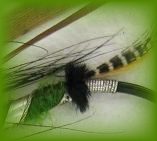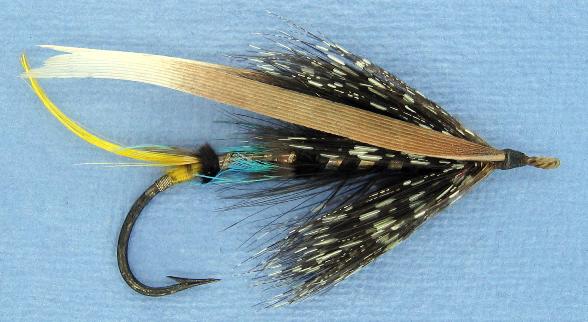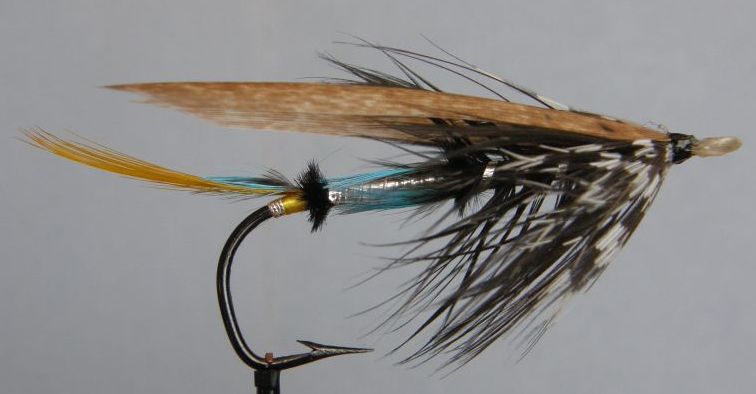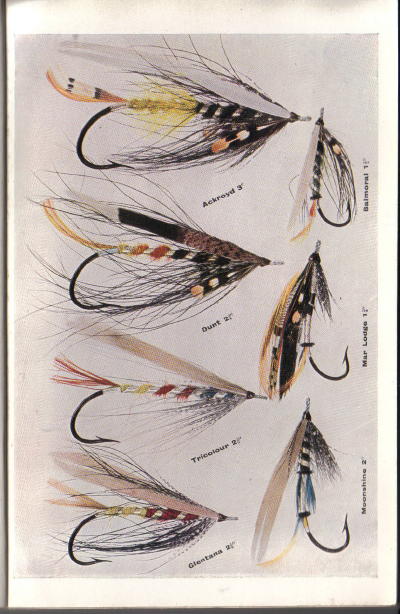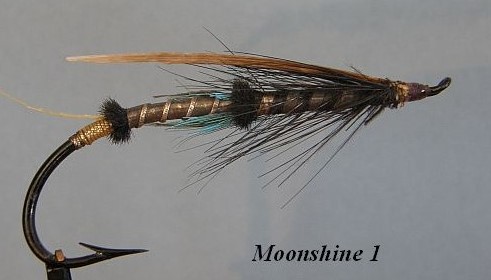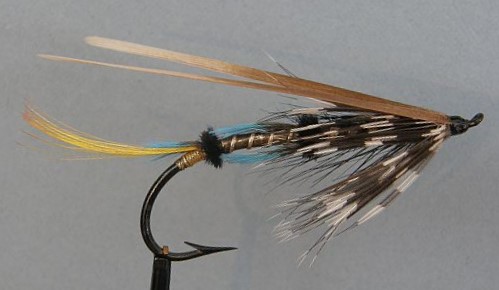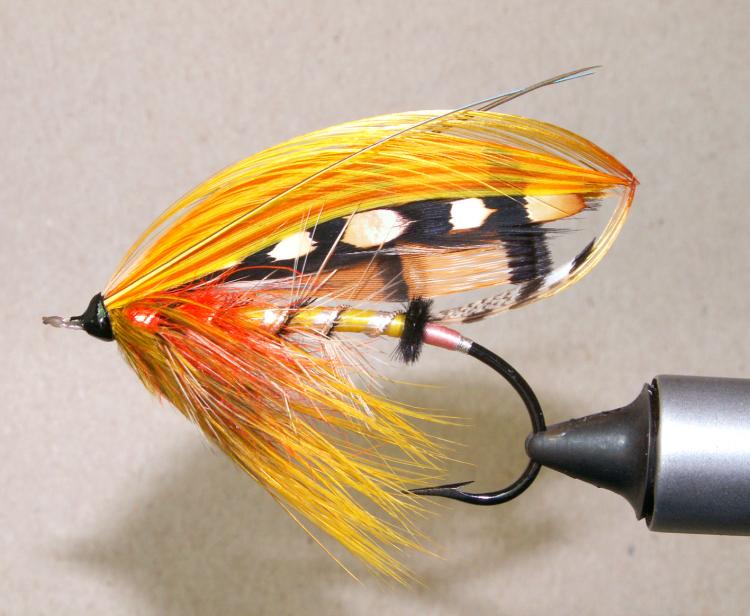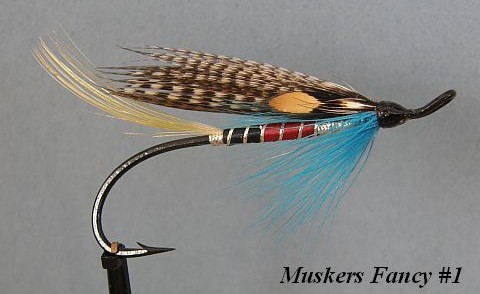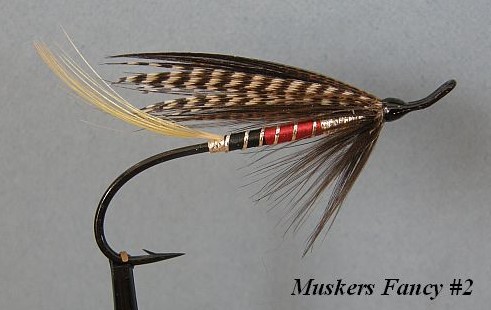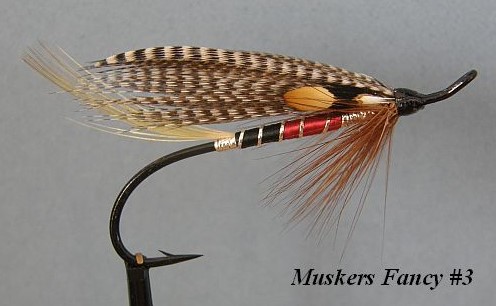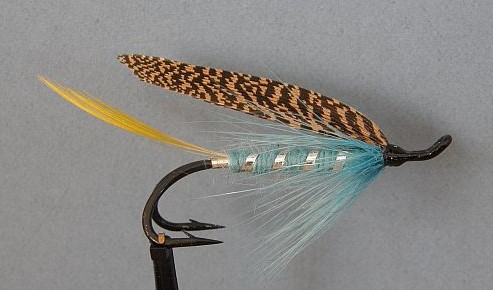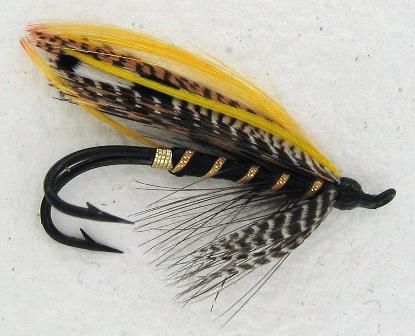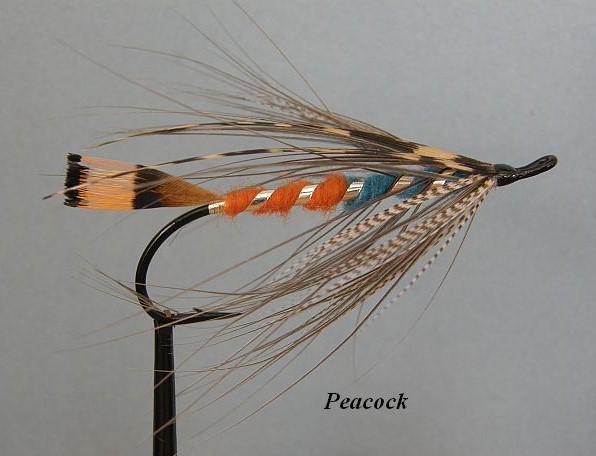 |
 |
|
Flies on this page, Monaltrie, Moonlight, Moray Doone, Musker's Fancies, Mrs Higginbotham, Mrs Hogg, Olga, Oliver, Peacock, please scroll down
The Moonlight caused me confusion for quite a while - I think that it is an error on the part of Mr Pryce-Tannatt, it is simply the Moonshine with a different tail and tag. I think all of the modern reference books have taken P-Ts interpretation "Moonlight" rather the more historically correct "Moonshine". This is an entirely separate fly to the "Moonlight on Mrs Higginbotham" which was tied by J.D. Greenway (and documented in his book; “Fish, Fowls & Foreign Lands”) for the river Em in Sweden and is not a Dee fly.
Tag: Silver tinsel. Tail: A topping and a pair of jungle cock feathers (back to back). Body: In two equal halves - first half, silver tinsel, veiled above and below with a pair (or two pairs) of blue chatterer feathers (back to back); second half, black floss. Ribs: Fine oval silver tinsel over flat silver tinsel; broader oval gold tinsel over black floss. Hackle: A black heron’s hackle over black floss. Throat: Speckled gallina. Wings: A pair of cinnamon turkey tail strips (set flat). Hook: 1½ to 3 inches. Moonshine Vintage 9/0
Forgive me for posting 3 of these vintage flies - the Moonshine perhaps coming from the firm of William Garden - is one of my most favorite of all the Dee flies and is a rare thing to find in vintage form. The first at the top is a awesome white winged 9/0 beauty. The Moonshine was listed in Gardens Catalogue c1917, but not in his slightly older catalogue of c1907 so I guess it came into being around 1910, it is also illustrated in Forrests Catalogue of the 1920s, shown below, and also the Drum fly is called the "Drum Moonshine".
Here is the dressing: To finish off the Moonshine section, here is an oldie that has been to hospital:
Before
After surgery from Dr Bob (like that hook!)
Moray Doone
Moray Doone by Dave Carne Kelson – The Salmon Fly, 1885 Tag: Silver twist and pink silk. Tail: A topping, peacock wing and summer duck. Butt: Black herl. Body: Quill dyed yellow, with four turns of red-orange seal’s fur at throat. Ribs: Silver tinsel (oval, narrow) and silver tinsel (flat, broad) Hackle: A silver coch-a-bonddu from second turn; hen pheasant hackle dyed yellow from seal’s fur. Throat: Widgeon. Wings: Two tippets (back to back). two extending Jungle (one on each side), swan dyed yellow and red-orange, and two toppings. Sides: Jungle. Horns: Blue macaw. Head: Black herl. A good early fly on the Hardy – Salmon Fishing, 1907 Tag: Silver tinsel; pink floss. Tail: Topping; peacock wing; summer duck. Butt: Black herl. Body: Quill dyed yellow with four turns of red orange seal’s fur at throat. Ribs: Silver tinsel (fine); Silver tinsel (broad). Hackle: Cock-a-bondu; hen pheasant dyed yellow. Throat: Widgeon. Wings: Two tippets; two extended jungle cock; yellow and red orange swan; two toppings. Sides: Jungle cock. Horns: Blue macaw. Head: Black.
Musker's Fancies
A vintage Musker's Fancy No. 2 Dressings from Frederick Hill – Salmon Fishing – The Greased Line on
The Musker’s fancy was invented in by Captain H.T. Musker around 1943 and considered by Hills as the best greased line fly for low water that he had used, they are made to represent the Logie, Blue Charm and Silver Blue.
Musker’s Fancy No.1 Tag: Silver tinsel. Tail: Topping. Body: Black, red silk, oval silver, equal parts. Rib: Silver tinsel, oval or round. Hackle: Blue. Wing: Teal and mallard mixed, jungle cock.
Musker’s Fancy No 2. Same dressing with black hackle in place of blue., No jungle cock.
No. 3 tied by Bob Frandsen Musker’s Fancy No 3. Same dressing with brown hackle in place of blue, with jungle cock. Mrs Hogg - See The Bruce Olga
The Olga was invented by J.L. Dickie and the dressing given in his book "Forty years of trout and salmon fishing" published in 1921 (worth getting for his descriptions of fishing on the Dee at Balmoral, even if he has a slightly arrogant style). He named the fly after his daughter.
Tied by Bob Frandsen Tag: Flat silver tinsel. Tail: Golden Pheasant. Body: Light blue wool. Ribbing: Flat silver tinsel. Hackle: Blue one shade darker than the body. Wing: The Olga is also mentioned as a
Oliver
A fly for fishing tied by Guy Heard WM Tag: Gold flat worm. Tail: A small topping. Butt: Black herl. Body: Black mohair, very, very sparely laid on. Ribbing: Gold flat worm: - five turns. Hackle: Black cock, rather sparely and fairly well down body. Shoulder: Teal. Wings: Mixed; peacock, pheasant, bustard, teal, summer duck, and yellow swan; topping all over. Head: Black herl. The “Oliver,” especially in the body, must be dressed neatly and sparely. Double Limericks – Sizes No. 4, 5, and 6. An excellent salmon and grilse pattern; fishes best in a fairish sized water on a clear day. Some hold is equal to, if not superior, to any of the
Peacock
Tied by Bob Frandsen, as Bob says - difficult to get a good photo on this little guy! WM Tag: Silver tinsel Tail: Double tippet, upright and proportionate with the size of the fly – for a No. 2 iron, about half an inch in length is a fair example. Body: An equal proportion of orange and greenish blue mohair – the former to be closest to tag. Ribbed: Flat tinsel (silver), 6 turns. Wings: Strips from peacock’s wing. Hackle: Grey heron, a third-way down body, fairly longish likewise, and spare. Shoulder: Teal (sparely) round about Head: Black. Limericks, Nos. 2, 3, 4, and 5. Though regarded principally as an evening lure, the “peacock,” if regulated in size, will be found a good all round fly. WM Tag: Silver tinsel Tail: two sprigs of tippet (set upright), half an inch in length, the bright side of both springs to face outwards. Body: Ribbed: Broadish flat silver tinsel and silver twist, five turns. Hackle: Good grey heron over the blue mohair only, and rather widely wound on so that there may not be more that 20 fibres altogether. Shoulder: Teal, sparingly. Wings: Well marked peacock strips; or, for the larger size of flies, distinctly barred black and white turkey strips. Head: Black. Mr. George Smith, Tackle Merchant, Ballater, has a splendid stock of these patterns, most of which are proved killer on all reaches above, and a good many reached below, that place.
|
